Related Research Articles

The pound or pound-mass is a unit of mass used in British imperial and United States customary systems of measurement. Various definitions have been used; the most common today is the international avoirdupois pound, which is legally defined as exactly 0.45359237 kilograms, and which is divided into 16 avoirdupois ounces. The international standard symbol for the avoirdupois pound is lb; an alternative symbol is lbm, #, and ℔ or ″̶.

The shilling is a historical coin, and the name of a unit of modern currencies formerly used in the United Kingdom, Australia, New Zealand, other British Commonwealth countries and Ireland, where they were generally equivalent to 12 pence or one-twentieth of a pound before being phased out during the 1960s and 1970s.

A penny is a coin or a unit of currency in various countries. Borrowed from the Carolingian denarius, it is usually the smallest denomination within a currency system. Presently, it is the formal name of the British penny (abbr. p) and the de facto name of the American one-cent coin (abbr. ¢) as well as the informal Irish designation of the 1 cent euro coin (abbr. c). Due to inflation, pennies have lost virtually all their purchasing power and are often viewed as an expensive burden to merchants, banks, government mints and the public in general.
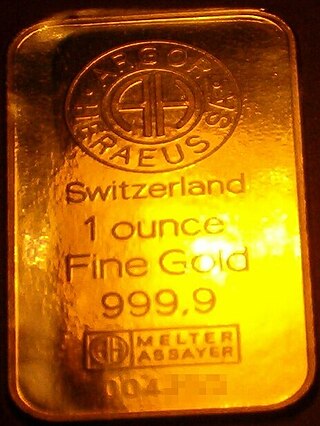
Troy weight is a system of units of mass that originated in 15th-century England, and is primarily used in the precious metals industry. The troy weight units are the grain, the pennyweight, the troy ounce, and the troy pound. The troy grain is equal to the grain unit of the avoirdupois system, but the troy ounce is heavier than the avoirdupois ounce, and the troy pound is lighter than the avoirdupois pound. One troy ounce equals exactly 31.1034768 grams.

The English penny, originally a coin of 1.3 to 1.5 grams pure silver, was introduced c. 785 by King Offa of Mercia. These coins were similar in size and weight to the continental deniers of the period and to the Anglo-Saxon sceats which had preceded it.

The franc, also commonly distinguished as the French franc (FF), was a currency of France. Between 1360 and 1641, it was the name of coins worth 1 livre tournois and it remained in common parlance as a term for this amount of money. It was reintroduced in 1795. After two centuries of inflation, it was redenominated in 1960, with each new franc (NF) being worth 100 old francs. The NF designation was continued for a few years before the currency returned to being simply the franc. Many French residents, though, continued to quote prices of especially expensive items in terms of the old franc, up to and even after the introduction of the euro in 2002. The French franc was a commonly held international reserve currency of reference in the 19th and 20th centuries. Between 1998 and 2002, the conversion of francs to euros was carried out at a rate of 6.55957 francs to 1 euro.

The livre tournois was one of numerous currencies used in medieval France, and a unit of account used in Early Modern France.
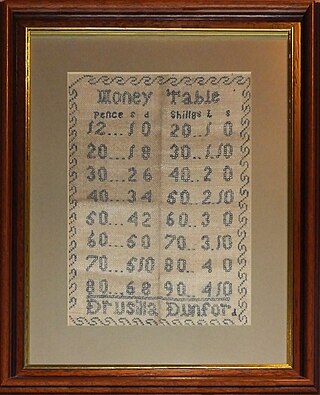
£sd is the popular name for the pre-decimal currencies once common throughout Europe, especially in the British Isles and hence in several countries of the British Empire and subsequently the Commonwealth. The abbreviation originates from the Latin currency denominations librae, solidi, and denarii. In the United Kingdom, these were referred to as pounds, shillings, and pence.
The 'pfennig' or penny is a former German coin or note, which was the official currency from the 9th century until the introduction of the euro in 2002. While a valuable coin during the Middle Ages, it lost its value through the years and was the minor coin of the Mark currencies in the German Reich, West Germany and East Germany, and the reunified Germany until the introduction of the euro. Pfennig was also the name of the subunit of the Danzig mark (1922–1923) and the Danzig gulden (1923–1939) in the Free City of Danzig.

Groschen a name for various coins, especially a silver coin used in parts of Europe such as France, some of the Italian states, England, various states of the Holy Roman Empire, among others. The word is borrowed from the late Latin description of a tornose, a grossus denarius Turnosus, in English the "thick denarius of Tours". Groschen was frequently abbreviated in old documents to gl, whereby the second letter was not an l, but an abbreviation symbol; later it was written as Gr or g.
The apothecaries' system, or apothecaries' weights and measures, is a historical system of mass and volume units that were used by physicians and apothecaries for medical prescriptions and also sometimes by scientists. The English version of the system is closely related to the English troy system of weights, the pound and grain being exactly the same in both. It divides a pound into 12 ounces, an ounce into 8 drachms, and a drachm into 3 scruples of 20 grains each. This exact form of the system was used in the United Kingdom; in some of its former colonies, it survived well into the 20th century. The apothecaries' system of measures is a similar system of volume units based on the fluid ounce. For a long time, medical recipes were written in Latin, often using special symbols to denote weights and measures.
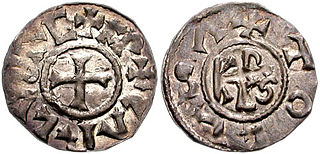
The denier or penny was a medieval coin which takes its name from the Frankish coin first issued in the late seventh century; in English it is sometimes referred to as a silver penny. Its appearance represents the end of gold coinage, which, at the start of Frankish rule, had either been Roman (Byzantine) or "pseudo-imperial". Silver would be the basis for Frankish coinage from then on. The denier was minted in France, Cyprus and parts of the Italian peninsula for the whole of the Middle Ages, in states such as the patriarchate of Aquileia, the Kingdom of Sicily, the Republic of Genoa, the Republic of Siena, Kingdom of Cyprus, and the crusader state Kingdom of Jerusalem, among others.

The Reichsthaler, or more specifically the Reichsthaler specie, was a standard thaler silver coin introduced by the Holy Roman Empire in 1566 for use in all German states, minted in various versions for the next 300 years, and containing 25–26 grams fine silver.
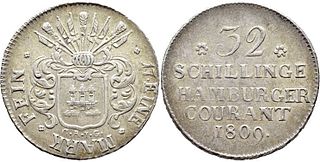
The Hamburg Mark refers to two distinct currencies issued in the city of Hamburg until 1875:
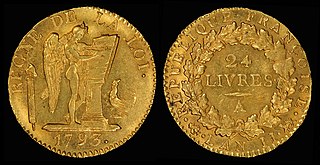
The livre was the currency of Kingdom of France and its predecessor state of West Francia from 781 to 1794. Several different livres existed, some concurrently. The livre was the name of coins and of units of account.

The traditional French units of measurement prior to metrification were established under Charlemagne during the Carolingian Renaissance. Based on contemporary Byzantine and ancient Roman measures, the system established some consistency across his empire but, after his death, the empire fragmented and subsequent rulers and variously localities introduced their own variants. Some of Charlemagne's units, such as the king's foot remained virtually unchanged for about a thousand years, while others important to commerce—such as the French ell used for cloth and the French pound used for amounts—varied dramatically from locality to locality. By the 18th century, the number of units of measure had grown to the extent that it was almost impossible to keep track of them and one of the major legacies of the French Revolution was the dramatic rationalization of measures as the new metric system. The change was extremely unpopular, however, and a metricized version of the traditional units—the mesures usuelles—had to be brought back into use for several decades.

The Sachsenpfennig, sometimes called the Wendenpfennig or the Hochrandpfennig was a well-known coin of the pfennig type minted in the eastern part of the Stem Duchy of Saxony during the 10th and 11th centuries. It had an upturned perimeter and, next to the Otto Adelheid Pfennig was the most common pfennig type of its time. Sachsenpfennigs are the oldest coins minted in Saxony. Its different names represent a lack of clarity within mediaeval numismatics about the coin.
A Münzfuß is an historical term, used especially in the Holy Roman Empire, for an official minting or coinage standard that determines how many coins of a given type were to be struck from a specified unit of weight of precious metal. The Münzfuß, or Fuß ("foot") for short in numismatics, determined a coin's fineness, i.e. how much of a precious metal it would contain. Mintmaster Julian Eberhard Volckmar Claus defined the standard in his 1753 work, Kurzgefaßte Anleitung zum Probieren und Münzen, as follows: "The appropriate proportion of metals and the weight of the coin, measured according to their internal and external worth, or determined according to their quality, additives and fineness, number and weight, is called the Münzfuß."

The schilling was the name of a coin in various historical European states and which gave its name to the English shilling. The schilling was a former currency in many of the German-speaking states of the Holy Roman Empire, including the Hanseatic city states of Hamburg and Lübeck, the March of Brandenburg, and the Duchies of Bavaria, Mecklenburg, and Württemberg. It was also used in Switzerland and in Austria, where silver schillings were introduced as recently as 1923.

The Carolingian monetary system, also called the Carolingian coinage system or just the Carolingian system, was a currency structure introduced by Charlemagne in the late 8th century as part of a major reform, the effects of which subsequently dominated much of Europe, including Britain, for centuries. It is characterised by having three denominations in the ratio 1:20:240, the units of which went under different names in the different languages, but which corresponded to the Latin terms libra (pound), solidus (shilling) and denarius (penny).
References
- ↑ Capitulare episcoporum, CCVI, dating from spring 793
- ↑ R. Leng, University of Würzburg: "Institut für Geschichte: Münzreform Karls des Großen". Archived from the original on 2016-12-03. Retrieved 2022-06-22.
{{cite web}}: CS1 maint: bot: original URL status unknown (link) 5 Gewichtspfund und Rechenpfund: "Ein karolingisches Pfund besaß ca. 408 gr." - 1 2 "troy, n.2". Oxford English Dictionary. Oxford, England: Oxford University Press. June 2012.
The received opinion is that it took its name from a weight used at the fair of Troyes in France
- ↑ Partridge, Eric (1958). "Trojan" . Origins: A Short Etymological Dictionary of Modern English. London: Routledge and Kegan Paul. p. 3566. OCLC 250202885.
…the great fairs established for all Europe the weight-standard Troyes, whence…Troy…
- ↑ Smith, L. Toulmin (1894). Expeditions to Prussia and the Holy Land Made by Henry Earl of Derby (afterwards King Henry IV.) in the Years 1390-1 and 1392-3. London: Camden Society. p. 100.
- 1 2 3 4 5 As. In: Meyers Konversations-Lexikon. 4th edition. Volume 1, Verlag des Bibliographischen Instituts, Leipzig/Vienna 1885–1892, p. 896–897.